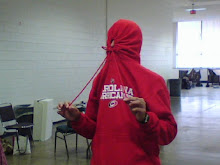There is an inherent problem with the NHL All-Star Game. It should be an exciting spectacle of high-talent, high-intensity hockey. The talent is high, but not always the intensity. Why? Because it's in the player's best interest (and that of the team he belongs to) to sandbag it. What incentive is there to play hard? Why risk injury? A Honda Pilot if you're named MVP? A little more bling for your trophy cabinet? Pretty insignificant when we're talking about multi-million dollar players who only lust for one, big trophy by the name of Lord Stanley's Cup.
Well, why not take a page from Major League Baseball and give the winning conference home ice advantage for the playoffs? Not only would that not sit well with hockey purists, it simply doesn't make sense for the NHL. Not a knock on baseball, but hockey is a full contact sport. In hockey, giving it your all means laying your body on the line every shift. Imagine this; Eric Staal goes all out, lays a full contact hit on an opposing player, and dislocates his shoulder. He's out for the season and for what? So divisional rival Washington can get home ice advantage and win the Cup? It doesn't make sense for hockey.
So how then? In what way do you bring out the intensity in the All-Star Game without risking a player's health? You don't. You can't and you don't. Part of the reason hockey is such an intense, uptempo sport is because there is that physical risk. Take it away and you lose the crux of the appeal.
Is it a lost cause then? Do we accept that the All-Star Weekend is a glorified breather for the players? After all, one of the best players in the game sat out the All-Star weekend (albeit due to "injury") and he lifted the big one over his head this summer. How can the NHL increase the appeal while maintaining as little risk as possible to the players? Simple; "John Kerry" the whole weekend and flip-flop the schedule. Make the All-Star Game itself the triumphant opening to the weekend and make the SuperSkills Competition the main attraction.
Seems counterproductive, right? Well, what is the All-Star Game for? It's supposedly to display the games greatest players and potentially entice more fans to watch the game. How does that work when those players are sandbagging it to prevent injury? It just ends up looking like Ice-Capades to the untrained eye. Do we really want a potential fan tuning into the All-Star game and thinking our beloved sport is boring? Not I.
So this flip-flop achieves what? Try to imagine this scenario. A guy/girl goes into work and says to his/her friends, "Did you see the NHL All-Star Game this weekend? There was this sweet tic-tac-toe pass on the game winning goal." Not exactly enthralling to a non-hockey fan. Okay, now try this one, "Did you see the NHL Super Skills Competition this weekend? This 6'9" guy hit a slap shot that was 105 miles an hour!" Which one are you more willing to tune into? The latter appeals to what American sports fans love so much about baseball; the stats. How fast can a player skate around the rink? How fast can he belt a slap shot? How fast can he break the targets? Not to mention the fact that there is a greatly reduced risk of injury in these events. It's all gravy.
Don't stop there either. Make more SuperSkills events that test other aspects of the game. Make the casual fan say, "Wow, I need to see that in a game!" It's better than, "This is what the best in the world has to offer? Boring!"
Monday, July 27, 2009
It Is Broke, So Fix It
Labels:
All Star Game,
Eric Staal,
hockey,
MLB,
NHL,
Sidney Crosby,
Super Skills,
Zdeno Chara
Subscribe to:
Post Comments (Atom)


No comments:
Post a Comment